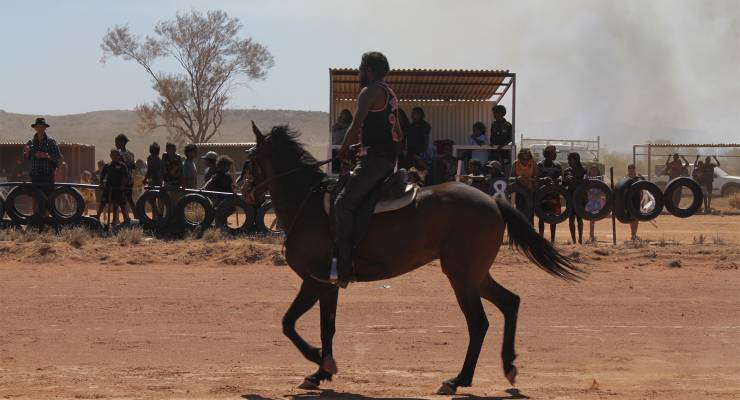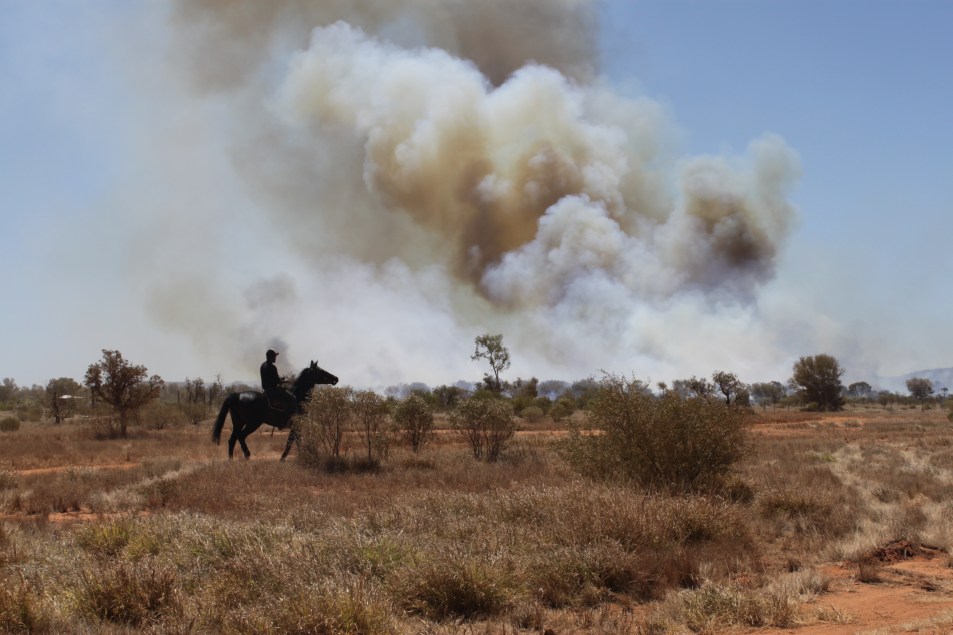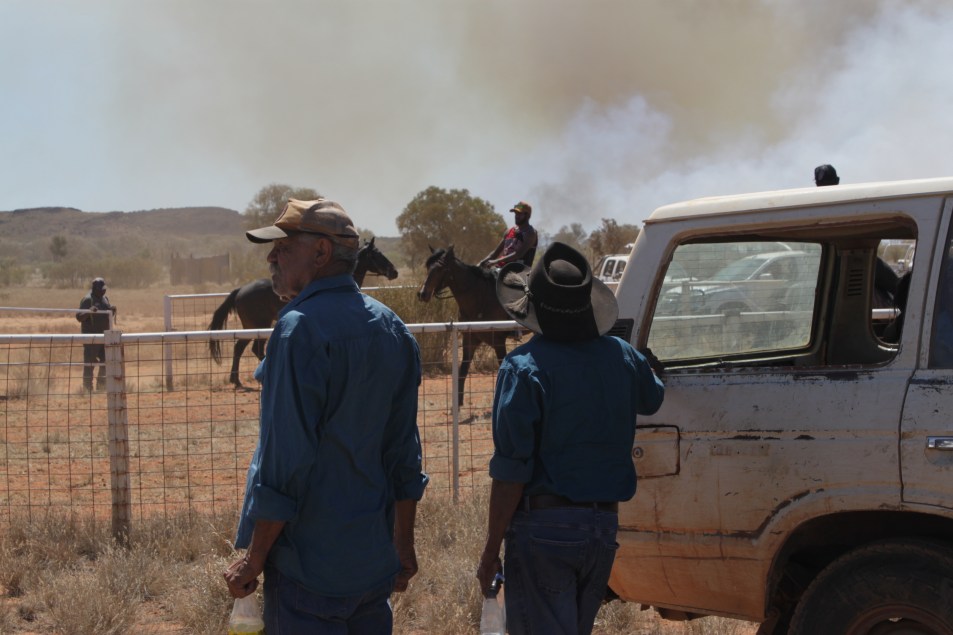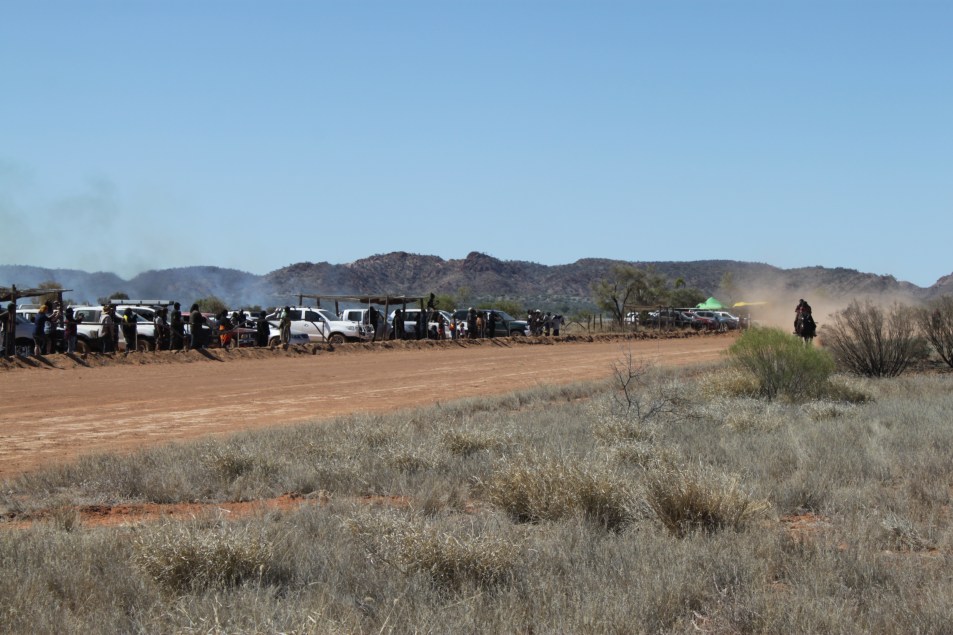
On Saturday, October 14, the national conversation was all polling booths, political appearances and last-minute pitches for a Yes-No vote on the Indigenous Voice to Parliament referendum. But in the remote Indigenous community of Ltyentye Apurte (Santa Teresa), around 80 kilometres south-east of Mparntwe (Alice Springs), all eyes and ears were on the finish line of an annual 800m, 1000m and 2000m horse race.
The two-day event was dust-heavy, shade-light and set to a backdrop of billowing smoke (courtesy of a bushfire that took hold before the first race), but no-one horse-top or trackside was particularly fazed.

“If you’re not here in one minute, too bad,” Ltyentye Apurte community leader Phillip Alice yelled over the loudspeaker to two riders not yet in the mounting yard.
Half an hour later the 800m local stockmen stockhorse race kicked off with five horses and an equal number of helmetless riders. Event advertising “encouraged” the use of helmets, as did Alice on the microphone, but he added these were experienced riders who knew the risks: “They’re the best, that’s why they’re racing.”
Both first and second place went to horses Caviar and Trinity from Walkabout Bore Outstation (approximately 108km south-west of Alice Springs), whose trainers Peter Kenny Junior, Peter Kenny Senior and Reggie Kenny told Crikey and reporting partner Indigenous Community Television (ICTV) that they’d had horses in the race every year since the early ’90s. During that time, they traded in foot transport for a horse float (trimming down the two-day journey to Ltyentye Apurte to one), took home many trophies (including a 16-cup winning streak), and most importantly continued to show up to “keep the race going for everybody.”

“It’s good for the community, good to see families and race against them,” Peter Senior said, adding that horses, horse races, and the art of horse training were diminishing in community.
Despite the “bring your own horse” advertising, Senior said there was nothing ad-hoc about the competition — these were not horses pulled “straight out of the paddock” and brought in for a fun run; they were broken-in, trotted, trained and “ready to run”, albeit in dwindling numbers.
“Everywhere you go, every community, no-one’s breaking them in anymore,” he said, adding that outstations had been overrun with “choppers and motorbikes” now operated by backpackers.
“There’s no-one around to get these young fellas from these communities to teach them. The old fellas that used to do it, they’re not out here anymore, they’re all gone. They’re in town, hanging around at Gillen Club. That’s why we’re trying to keep it going.”
The Kenny family said that the Ltyentye Apurte turnout was nothing like it used to be, but they were pleased to see a few new “outsiders” signing up to compete, including horses from Ntaria (Hermannsburg) and Mulga Bore.
“Last year, it was just us and old Raymond Palmer,” Peter Senior said, nodding towards the local Ltyentye Apurte horse owner.
From the sidelines, behind rows of tyres, 70-odd cars full of family, friends and horsing enthusiasts had parked up to see the event unfold. Kids adorned the mounting yard fence, while others set up camp at various spots along the track where horses were tethered in shaded holding yards.

“Are you riding?” Crikey and ICTV asked one man, who was bent over a fresh kangaroo tail cooking on the fire.
“Nah, just here for the show,” he responded as a wild stallion attempted to serenade and breach the fence between itself and three prospective mares being readied to race.
On the back of horse chat, Crikey and ICTV asked horse owners, riders and onlookers if and how they’d voted in the referendum. Some said yes and Yes, while others (including those not from Ltyentye Apurte) said no and still unsure.
The community was given the opportunity to vote on October 2 and 3 as part of the Australian Electoral Commission (AEC)’s remote voter service. Atyenhenge Atherre Aboriginal Corporation reported 191 residents cast a ballot during those two days.
AEC Tally Room data indicates that the NT vote for the division of Lingiari — inclusive of Alice Springs, Ltyentye Apurte and many other remote Indigenous communities — was overall 44.3% in favour of Yes and 55.7% No.
Data for the 22 remote mobile teams that serviced communities with majority Indigenous populations shows that all bar one voted majority Yes. The one remote vote in favour of No was inclusive of the Darwin postcode of 0822 and won by a single-percent majority (49% Yes to 51% No). Overall there were 12,312 remote votes cast and 8,894 (72%) voted Yes.
Alice told Crikey and ICTV that he expected most people from the local community had cast a ballot one way or other a few weeks back during the remote voter service, leaving the referendum weekend to focus on the horse race that — although no Melbourne Cup with “millions of people” — was “most important” to the community.
“Look at those kids running around,” he said. “They’re just enjoying it. And families are everywhere — you can see the families all sitting together and telling stories.”









Great to read, Julia and Steve ( though I’m not a great fan of “Melbourne Cup” type races.) The closest I have been was a camel race in Young NSW (horses could not travel because of the hendra virus I think! Thnak you.